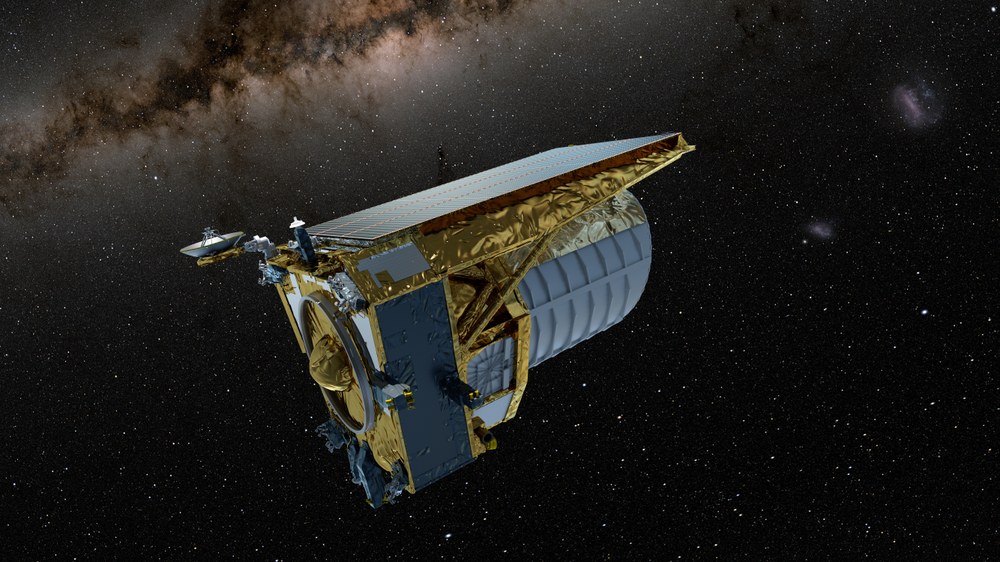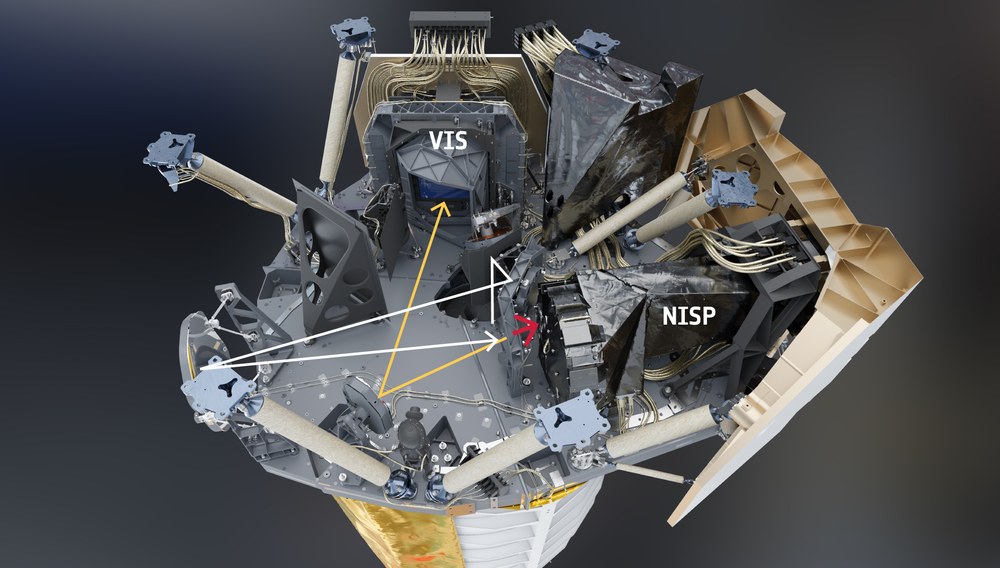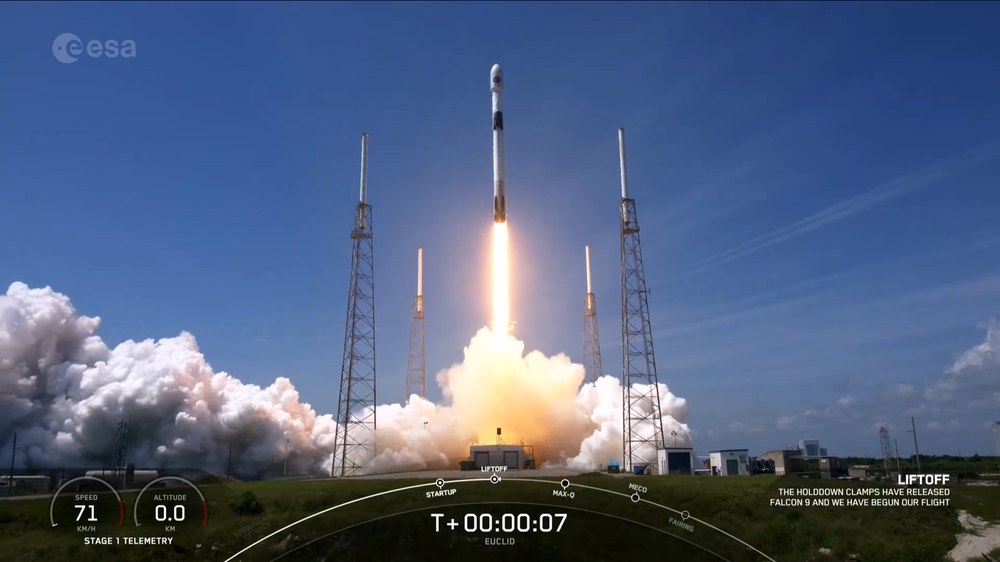Exploring the geometry of the dark Universe


- On 1 July 2023, the European space telescope Euclid is scheduled to launch from the US spaceport at Cape Canaveral and embark on its way to the second Lagrange point of the Sun-Earth system.
- Euclid is on the trail of the two great unknowns in the Universe – dark matter and dark energy.
- The German Space Agency at DLR is responsible for coordinating the nation's ESA contributions. It is also funding one of the telescope's two instruments with more than 60 million euros from the National Space Programme.
- Focus: Spaceflight, cosmology, Solar System exploration
+++ Update: On 1 July 2023 at 17:12 CEST, a Falcon 9 rocket operated by the US company SpaceX successfully launched the ESA Euclid spacecraft from the US spaceport at Cape Canaveral. At 17:56 CEST, Euclid's first signal was received at ESA's European Space Operations Centre (ESOC) in Darmstadt. Euclid is now on a four-week journey to its destination, 1.5 million kilometres from Earth – the second Lagrange point (L2) of the Sun-Earth system. +++
Euclid of Alexandria is considered to be the 'father' of geometry. In his most famous work, 'Elements', he brought together the knowledge of mathematics available in his time, presented it in a consistent way and defined a strict method of proof that became the model for later mathematics. Many structures, theorems and proofs are therefore named after Euclid – and now also a space telescope. The European Space Agency (ESA) Euclid mission is scheduled to launch on 1 July 2023 atop a Falcon 9 rocket from the US company SpaceX. With this mission, researchers want to find out more about how the geometry of the Universe changes based on the matter and energy it contains.
After a four-week journey, the telescope, which weighs approximately two tonnes, will rotate in an orbit around the second Lagrange point (L2), which lies 1.5 million kilometres from Earth in the opposite direction to the Sun. L2 is an equilibrium point of the Sun-Earth system that follows Earth on its orbit around the Sun. Germany is the largest contributor to the ESA science programme and is funding approximately 21 percent of the Euclid mission. The German Space Agency at the German Aerospace Center (Deutsches Zentrum für Luft- und Raumfahrt; DLR) is responsible for coordinating the nation's ESA contributions on behalf of the Federal Ministry for Economic Affairs and Climate Action (Bundesministerium für Wirtschaft und Klimaschutz; BMWK). The Agency is also funding one of the telescope's two instruments, including the development of the software used for data processing and a data centre. More than 60 million euros are being provided through the National Space Programme. The funding runs until the end of the six-year mission.
"The European Euclid mission will help astronomers decipher as yet unsolved mysteries in cosmology. Like its prominent namesake, the European space telescope will use geometry, in this case of the Universe, to search for dark matter and dark energy. Together, these components make up 95 percent of the Universe. But their secrets have remained hidden until now. With Euclid, Europe, together with our partners from Canada, Japan and the USA, will help to shed light on the darkness of the Universe," emphasises Walther Pelzer, DLR Executive Board Member and Director General of the German Space Agency at DLR.
Dark matter and dark energy – two great unknowns in the equation of the Universe
ESA's Planck mission confirmed that the Universe has a flat – also referred to as Euclidean – geometry and lies exactly on the dividing line between eternal expansion and collapse. This characteristic depends on the density of all matter in the Universe. However, all the visible matter in the Universe – for example clusters of galaxies and stars – accounts for only five percent of the mass required for a flat Universe. So, in the equation of the Universe, there had to be something unknown that lies in the dark next to the visible matter – something that does not interact with light. This constituent was named 'dark matter' by astronomers.
In 1929, Edwin Hubble observed that galaxies are moving away from Earth and the more distant galaxies are moving away faster than nearby galaxies. This result provided evidence that the Universe is expanding. Then in 1998, future Nobel Prize winners Saul Perlmutter, Brian Schmidt and Adam Riess discovered that this expansion of the Universe may even have accelerated in the last 10 billion years. This discovery has enormous implications for cosmology, because to explain this acceleration, another unknown has to be missing from the equation of the Universe. There must be a negative pressure pushing the Universe apart – astronomers have named this unknown 'dark energy'.
NISP and VIS – on the trail of the unknowns with two instruments
"Euclid will look back 10 billion years into the cosmic past and study the geometry and expansion of the Universe. The space telescope will map the distribution of dark matter across more than one-third of the sky in three dimensions and study the distribution of galaxy clusters in this time interval, during which dark energy played an important role. For this purpose, the spacecraft is equipped with a telescope and two instruments, the Near Infrared Spectrometer and Photometer (NISP) and the Visible Instrument (VIS)," explains Alessandra Roy, Euclid Project Manager at the German Space Agency at DLR.
The telescope has a diameter of 1.2 metres and guides the infrared part (wavelength between 900 and 2000 nanometres) of the light to the NISP instrument. It also reflects the visible light (wavelength between 550 and 900 nanometres) into the VIS instrument. To achieve the mission's scientific goals, Euclid researchers need to know the brightness of any observed galaxy as a function of its distance in both the visible and infrared wavelength ranges. This is achieved using VIS and the near-infrared photometer component of NISP. The near-infrared spectrometer measures the 'hydrogen fingerprint' in galaxy clusters to determine the change in the expansion rate of the Universe.
How Euclid will bring light into the dark Universe
To explore the nature and spatial distribution of the Universe, dark matter is measured using the 'weak gravitational lensing' effect. This effect was predicted to exist by Albert Einstein's General Theory of Relativity, according to which every massive body curves the space surrounding it like a ball on an elastic surface. If dark matter were to be present along the line of sight when observing distant galaxies, the galaxy shapes would be distorted. By studying this distortion, Euclid will map the mass distribution of dark matter in three dimensions.
Euclid will measure the distance between clusters of galaxies and use this as a standard ruler for measuring the expansion rate of the Universe. By determining the distance between individual pairs of clusters, astronomers can find out the most likely separation between any two galaxies at a certain time in the Universe. Astronomers know that the most likely distance between two galaxies today is approximately 500 million light years. This scale was imprinted on the Universe in its early stages and changes as it expands. This arises from a phenomenon referred to as 'baryonic acoustic oscillations'. Euclid will perform a galaxy redshift survey and measure this effect using tens of millions of hydrogen spectra in the observed galaxies over a look-back period of 10 billion years, during which the expansion of the Universe is thought to have accelerated.
Euclid – a European mission and its partners
Euclid is the second M-class mission in ESA's 'Cosmic Vision' programme. The service module and satellite platform were supplied by Thales Alenia Space. The two instruments were provided by a consortium consisting of 14 ESA member states (Austria, Belgium, Denmark, France, Finland, Germany, Italy, the Netherlands, Norway, Portugal, Romania, Spain, Switzerland and the United Kingdom), Canada, Japan and the USA, involving 2600 researchers. The payload module was the responsibility of Airbus. It includes the telescope, the thermal control system, the fine control sensor and the two scientific instruments contributed by the international Euclid consortium.
The studies on the NISP instrument were led by the Max Planck Institute for Extraterrestrial Physics in Garching in collaboration with the Max Planck Institute for Astronomy in Heidelberg. In addition, the Ludwig-Maximilians-Universität in Munich, the Rheinische Friedrich-Wilhelms-Universität in Bonn and the Ruhr-Universität Bochum developed software for Euclid and are contributing considerable financial resources. Other contributions come from the Astronomy Technology Centre in the UK, the Commissariat à l'énergie atomique et aux énergies alternatives in France and the Jet Propulsion Laboratory in the USA. Germany is the largest contributor to the ESA science programme, contributing approximately 21 percent to this programme. The German Space Agency at the German Aerospace Center (Deutsches Zentrum für Luft- und Raumfahrt; DLR) is responsible for coordinating the nation's ESA contributions on behalf of the Federal Ministry for Economic Affairs and Climate Action (Bundesministerium für Wirtschaft und Klimaschutz; BMWK). The Agency is also funding one of the telescope's two instruments, including the development of the software used for data processing and a data centre. More than 60 million euros are being provided through the National Space Programme. The funding runs until the end of the six-year mission.

